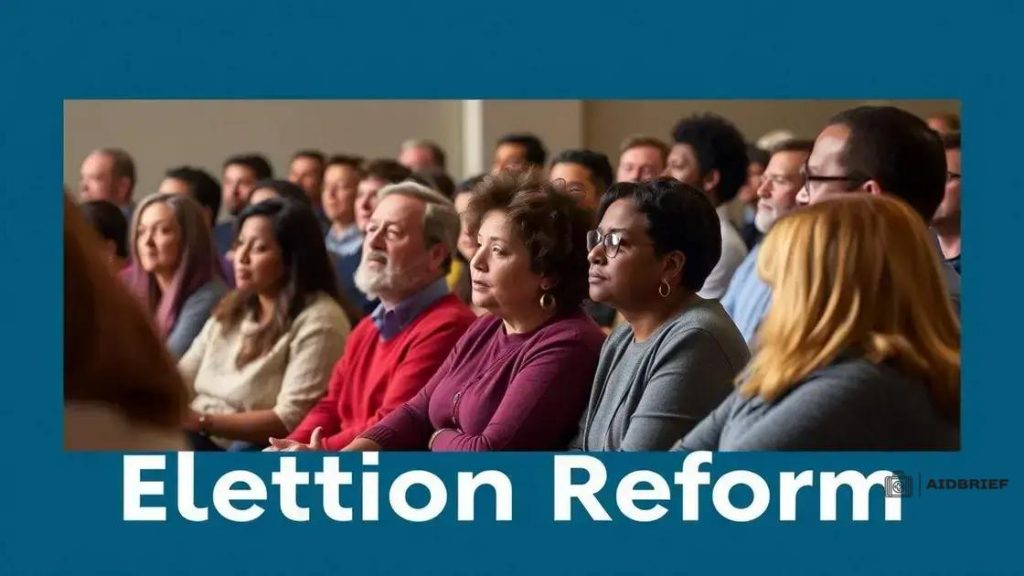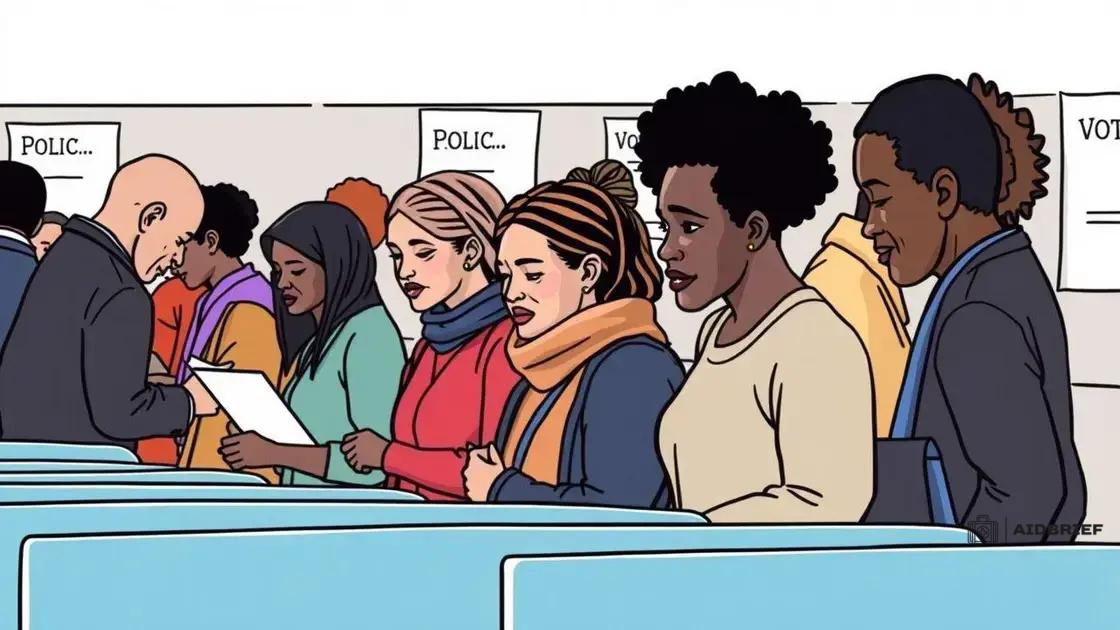Election reform 2025: What changes are necessary?

Election reform focuses on improving the electoral process through technology, public engagement, and advocacy to ensure fair access and representation for all citizens in a democratic society.
Election reform 2025 is on the horizon, and it’s a topic that affects us all. Have you ever wondered how changes in voting laws impact your voice in democracy? Let’s delve into what’s being discussed.
Current state of voting laws
The current state of voting laws is crucial for understanding how elections are conducted in our democracy today. It’s important to recognize that these laws can vary greatly from one state to another. Some states are implementing new measures while others are facing challenges that hinder progress.
Recent Changes
Many states have recently adopted laws aimed at making voting more accessible. For instance, online voter registration has gained popularity, allowing ease of access for many voters. Additionally, extended voting periods and early voting options are being expanded to accommodate diverse needs.
- Online voter registration
- Extended voting periods
- Early voting options
- ID requirements
However, the debate over voter ID laws continues, creating divides on whether such measures protect elections or suppress voter turnout. Understanding these laws is key, as they directly impact how citizens can participate. As some laws aim to enhance security, others may inadvertently make it harder for individuals to cast their ballots.
State-by-State Differences
States showcase a wide range of voting laws, each reflecting their political climate and public sentiment. In some places, you will find that mail-in voting is widely accepted, while in others, strict regulations limit who can apply. These differences highlight the uneven landscape of voting access in the United States.
The conversation surrounding voting laws reflects deeper societal values, making it essential to stay informed. By being aware of how these laws evolve, citizens can better engage in advocacy and strive for reforms that ensure fair access for all.
As we explore the implications of these laws on election reform, it becomes clear that addressing these issues is vital for a thriving democracy.
Impact of technology on elections
The impact of technology on elections has been profound, reshaping how citizens engage with the electoral process. With advances in digital tools, the landscape of voting is changing. Technology enables voters to access information more easily and participate in new ways.
Digital Voting Systems
Many regions have adopted digital voting systems, providing a faster and more efficient way for people to cast their ballots. These systems can reduce wait times and help streamline the voting process. Voters appreciate the convenience of being able to vote online, especially when mobility or health concerns arise.
- Online voting platforms
- Electronic ballot machines
- Improved vote counting accuracy
- Accessibility for people with disabilities
However, reliance on these systems raises questions about security and the potential for cyber threats. As more elections utilize technology, ensuring the integrity and security of the voting process becomes vital.
Voter Engagement through Social Media
Another major way technology impacts elections is through social media. Platforms like Facebook and Twitter play a significant role in shaping public opinion. Candidates can directly communicate with voters, share their platforms, and engage in discussions. This real-time interaction creates a dynamic exchange.
Despite its advantages, social media also presents challenges. Misinformation can spread quickly, influencing voter perceptions negatively. Therefore, it is essential for voters to critically evaluate the information they encounter.
The importance of technology in elections will only grow in upcoming years. As we continue to embrace digital solutions, understanding their implications is key. Balancing the benefits of technology with its risks will shape the future of our democratic processes.
Voter participation trends

Understanding voter participation trends is vital for seeing how engaged citizens are in the electoral process. Over the years, there have been notable shifts in the number of people casting their votes, reflecting various social and political factors.
Increasing Awareness and Engagement
In recent elections, more people have become aware of their rights and the importance of their vote. This heightened awareness is leading to higher voter turnout. Many organizations are actively encouraging participation through campaigns and educational programs.
- The role of grassroots movements
- Impact of social media campaigns
- Importance of voter education
- Outreach in underrepresented communities
However, despite these positive trends, challenges remain. Certain demographics, such as young voters, often have lower participation rates compared to older citizens. Understanding why specific groups choose to vote—or not to vote—is critical for future reforms.
Barriers to Participation
Barriers like lack of access to polling places, complicated registration processes, and restrictive voting laws can discourage participation. Many individuals face obstacles that make it difficult for them to cast their ballots, leading to gaps in representation.
Efforts to address these barriers are essential. Initiatives aimed at improving accessibility can help ensure that everyone, regardless of their circumstances, can participate in the democratic process. As we continue to monitor voter participation trends, it becomes clear that ensuring fair access is vital for a healthy democracy.
Tracking these trends will help inform future election reforms, guiding policymakers to create a more inclusive electoral system.
Key challenges in reforming election laws
Reforming election laws presents several key challenges that lawmakers and citizens must address. Understanding these challenges is essential for creating a fair and effective electoral system. Various factors can hinder the progress of meaningful reforms.
Political Resistance
One significant challenge is political resistance. Many lawmakers may be reluctant to support changes that could affect their party’s power dynamics. This resistance can slow the process of enacting reforms, especially when partisan interests take precedence over constitutional values.
- Fear of losing electoral advantages
- Partisan disagreements on best practices
- Lobbying pressures from special interest groups
- Influence of outdated laws
Additionally, public opinion plays a vital role. When reform proposals are not well understood, voter resistance can grow, leading to a stalemate in legislative bodies.
Public Awareness and Education
Another challenge is the need for greater public awareness and education on election laws. Without a clear understanding of the implications of proposed reforms, citizens may not support necessary changes. This lack of information can stall initiatives aimed at improving accessibility and fairness in elections.
Efforts to educate the public and spark conversation are crucial for creating a supportive environment for reforms. Engaging communities through town halls, workshops, and informational campaigns can help inform voters about the benefits of revised laws.
As we navigate these challenges, it’s vital to create a collaborative approach involving lawmakers, advocacy groups, and the public to drive effective reform in our election systems. Understanding and addressing these challenges will lead us closer to a more equitable democratic process.
Future outlook for election reform
The future outlook for election reform is an important topic as society continues to evolve. With changing demographics, technology advancements, and increasing public interest, the landscape of elections is poised for transformation. Understanding these trends can help us grasp where electoral processes are headed.
Technological Integration
One significant factor shaping the future is the integration of technology. As seen in recent elections, the use of digital tools can improve voter access and participation. Future reforms may focus on enhancing these technologies to make the voting process more secure and user-friendly.
- Enhanced online voting options
- Improved cybersecurity measures
- Real-time voter education platforms
- Accessibility features for disabled voters
These innovations have the potential to engage more citizens and make voting easier for everyone, but they must remain secure to maintain trust in the system.
Public Advocacy and Engagement
As the awareness of voting rights grows, public advocacy for reform is likely to strengthen. Grassroots movements across the country are emphasizing the importance of fair access to the ballot. Increased participation in these movements can lead to significant sway in policy-making.
Additionally, advocacy groups are working to combat misinformation that can deter voter engagement. This focus will be essential in shaping public perceptions about electoral processes and encouraging informed participation.
Ultimately, the future of election reform will depend on collaboration among lawmakers, advocacy groups, and the public. By continuing to address barriers and embrace innovations, societies can create electoral processes that are more just and representative of all citizens.
FAQ – Frequently Asked Questions about Election Reform
What is election reform?
Election reform refers to efforts aimed at improving the electoral process, making it more accessible, fair, and secure for all voters.
How does technology impact the voting process?
Technology enhances the voting process by providing tools such as online voting, improving accessibility, and increasing accuracy in vote counting.
Why is public awareness important for election reform?
Public awareness is crucial because an informed electorate can advocate for necessary changes and support reforms that promote fair voting practices.
What are some challenges faced in reforming election laws?
Challenges include political resistance, misinformation, and barriers that prevent certain groups from voting, all of which make meaningful reform difficult.





